
Corallina vancouveriensis
Graceful Coral Seaweed
Harling Point, Juan de Fuca Strait, British Columbia, Canada
12 April 2020
Observed/interacted with at 1:35 pm PDT
Low
Tide 1.6 feet at 1:47pm PDT (measured at Oak Bay Tidal
Station)
Weather: Sunny, very light winds, very calm sea, light
ship generated swell, temperature 14.5˚, relative humidity 18%.
Phase of Moon: Waning Gibbous (Previous Phase, Full Moon, 7 Apr 2020 7:35pm PDT: Next Phase, Third Quarter, 14 Apr 2020, 3:56pm PDT).
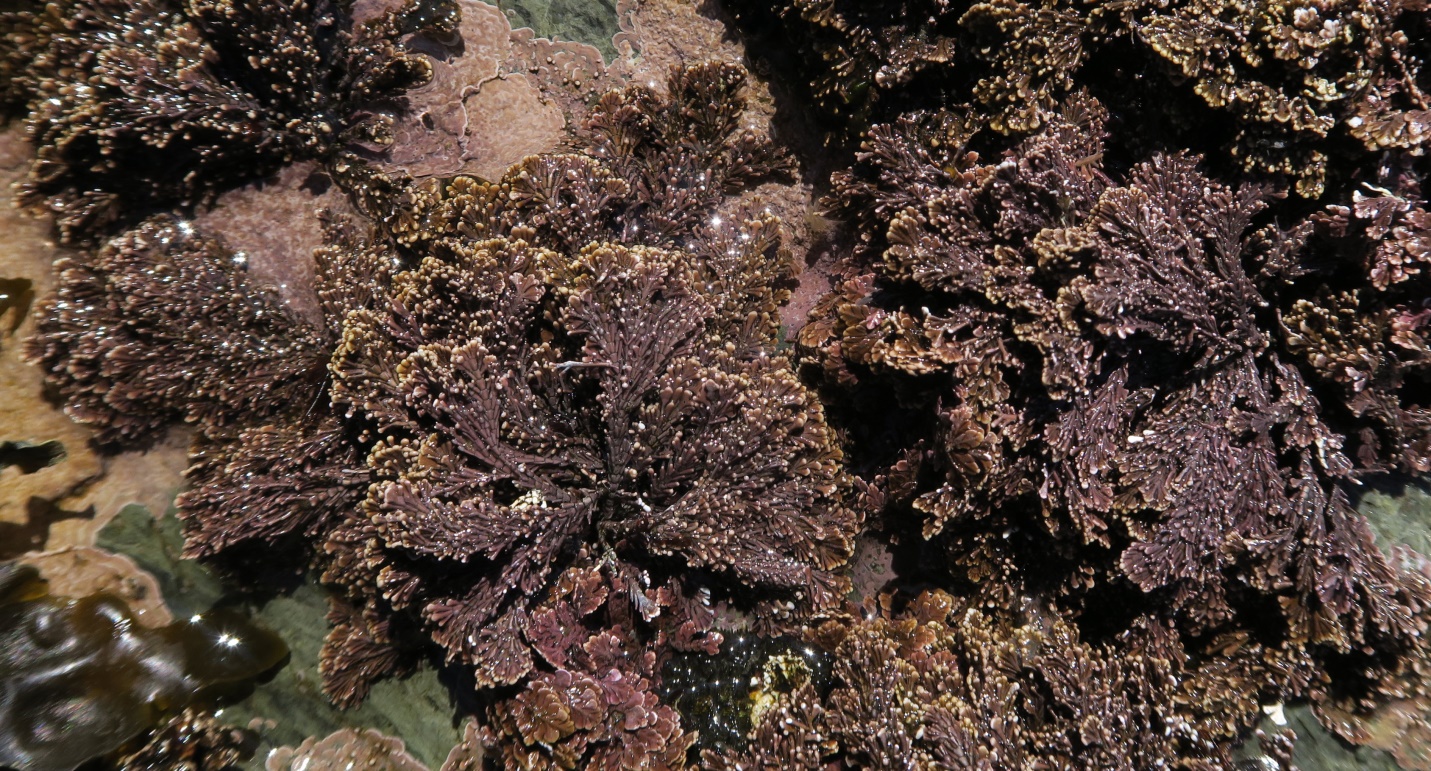
Figure 1: Corallina vancouveriensis in situ, Harling Point, Juan de Fuca Strait, BC, Canada. April 12, 2020. Photo ID 27193 ©Seaweedwhisperings.com
In situ observations:
Person 1:
From a distance looks like a pinkish moss.
Radiating hand with short fingers, maybe chopped off.
Looks tough from a distance.
Looks tough but feels soft.
Stringy appearance.
Rippled appearance to top of clusters – breaks impact of crashing waves?
Small bumps on upper surfaces rounded – pleasant to run fingers along. Want to keep running my thumb over surface – feels physically pleasurable.
Looks complex but feels simple.
Visually pleasing color combo – shades of pinks and grey.
Person 2:
Kelp flies, you may perch and crawl, but I don’t even feel your feet on my branches.
Tide is out, my “feet” are wet, but my stem and branches are drying in the sun and breeze.
But I’m good.
I can wait.
Slow is my tempo.
Things nearby are rotting – I’m indifferent.
It is notable that with this interaction I chose immediately to “speak” in the first person narration for Corallina.
Now speaking as myself, Person 2: Saw a pattern of concentric circles (like the ripple pattern created from a pebble dropped into water) overlaying the Corallina patch I was observing. I blinked, and it was gone.
“Circle” significant?
Pink – turns grey in too much light? When dead?
Pink is life, grey is death.
Moves stiffly with water movement – controlled like the wave of the “queen” – not exuberant.
Fan of frills.
Let me look closer.
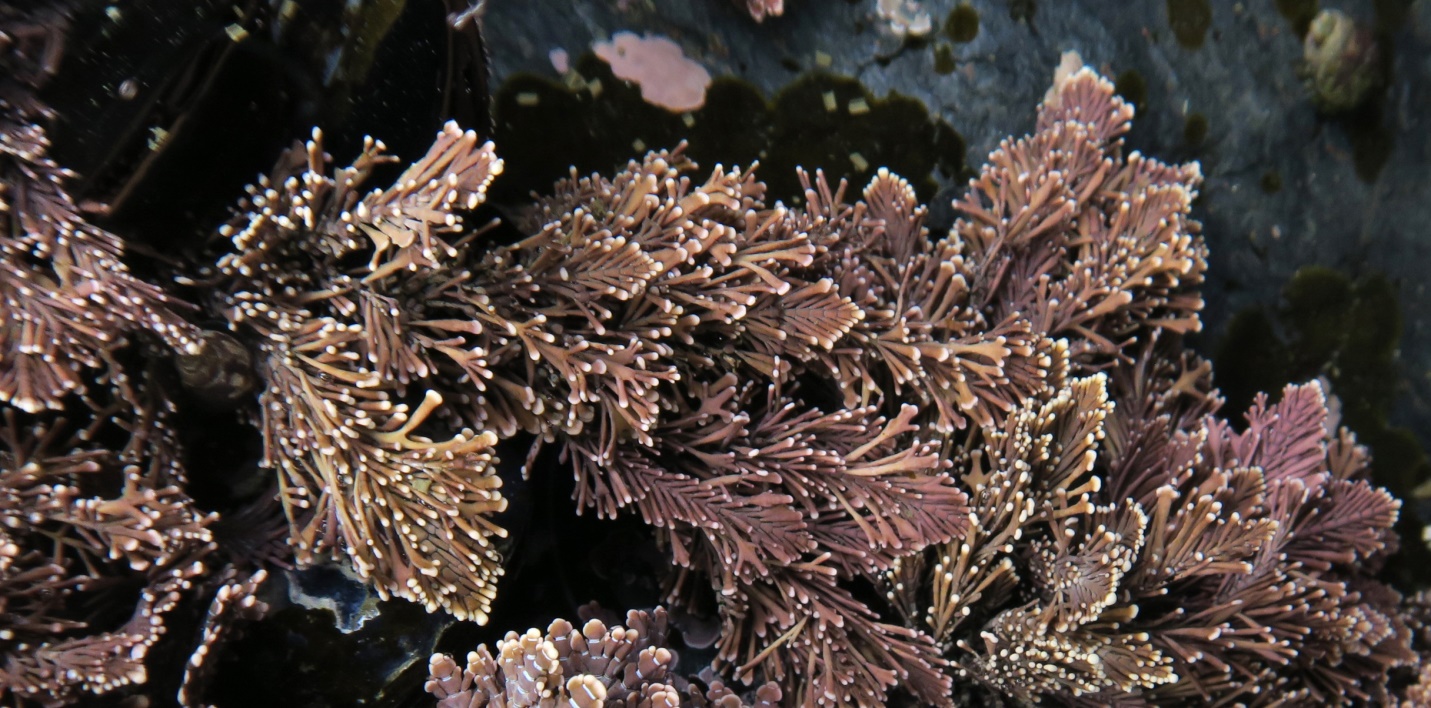
Figure 2: Seen here are mainly the pink-colored, white-tipped, finely pinnate thalli of Corallina vancouveriensis; one other like-colored coralline algae species displays its “wingnut” morphology at the very bottom and center of the photo. Botany Bay, Juan de Fuca Strait, BC, Canada. June 11, 2020. Photo ID 27194 ©Seaweedwhisperings.com
Observations Continue:
Person 1:
Spun on its axis in spirals when water was poured over the specimen I’m observing in a basin of seawater.
Overall visual impression is of the camouflage pattern of large sculpins (from the family of fish named Cottidae).
Pale-colored frond edges create an extra dimension of beauty, maybe like frills on a dress or fringe on a female horseback or motorcycle rider’s jacket.
Can see bilateral symmetry to this seaweed similar to that of a butterfly.
When at rest, seaweed looks like a thick fur coat poorly groomed.
Partially closing my eyes, I see a forest.
Branches have five fingers.
Unremarkable, but pleasant feel when rubbed on various parts of my face.
Played with the specimen, lifting and watching it spread as I plunged it deeper in the basin of water – didn’t want to stop playing – simple pleasure.
When pushed down in the water to the bottom of the basin (held by the base of stem) the seaweed is shaped like a Christmas tree.
Smell and taste obscured by saltwater effect.
Shocked by crunchy, granular texture – couldn’t get a good taste sensation.
Common name, Graceful Coral Seaweed has a light, happy feel to it, brings pleasurable images.
Images of frills dancing in the water.
Scientific name rolls off tongue lightly and pleasantly.
Wish I was an animal (a coral) instead of a plant?
Person 2:
Layered branches – each fanning out to a broad tip with a gentle point.
Tight and tiny.
Want to look closer (got out hand lens to do so).
Leading tips are rounded and pale greyish/whitish pink – is this the fresh new growth?
Critters hide in the branchlets; marine invertebrates underwater, flies above water – their busy, erratic movements distract from my ‘seeing’ the alga.
Looks like a type of conifer, but the color – pink, brown-y purple and pinky white make it impossible to confuse with an actual conifer – pink defines this as a coralline algae.
Spreading, branching, reaching up and out.
Knobby to the touch.
Like pumice – much lighter than you might expect.
Strong – resists light to medium touch – armoured.
Brittle to firmer touch on being squished. Branch bits break off – is the whole ok?
Will it grow where broken? Pruned?
Rubbing on my chin, feeling is almost of sand, but this “sand” is strung together (doesn’t separate into particles) and feels rounder.
Does not feel “alive”.
Feels fossilized – no tender growing ‘plant’ parts.
No smell I can detect.
Taste – salt of seawater.
Texture on teeth like sand or grit – hard, coarse, abrasive.
No desire to eat this seaweed.
Chew too much and feel certain I could harm my teeth.
“Graceful” coral name – no sharpness to the alga, so this fits, and any movement of this alga is in gentle waves – not forceful, so again, graceful is a good choice.
Looks like coral – a colonial animal; does it serve you to look more like an animal than an alga…, hmnnnn?
“Corallina” – has a “pretty” feminine sound – but this plant is tough “like grit” – so, don’t judge a book by its cover!
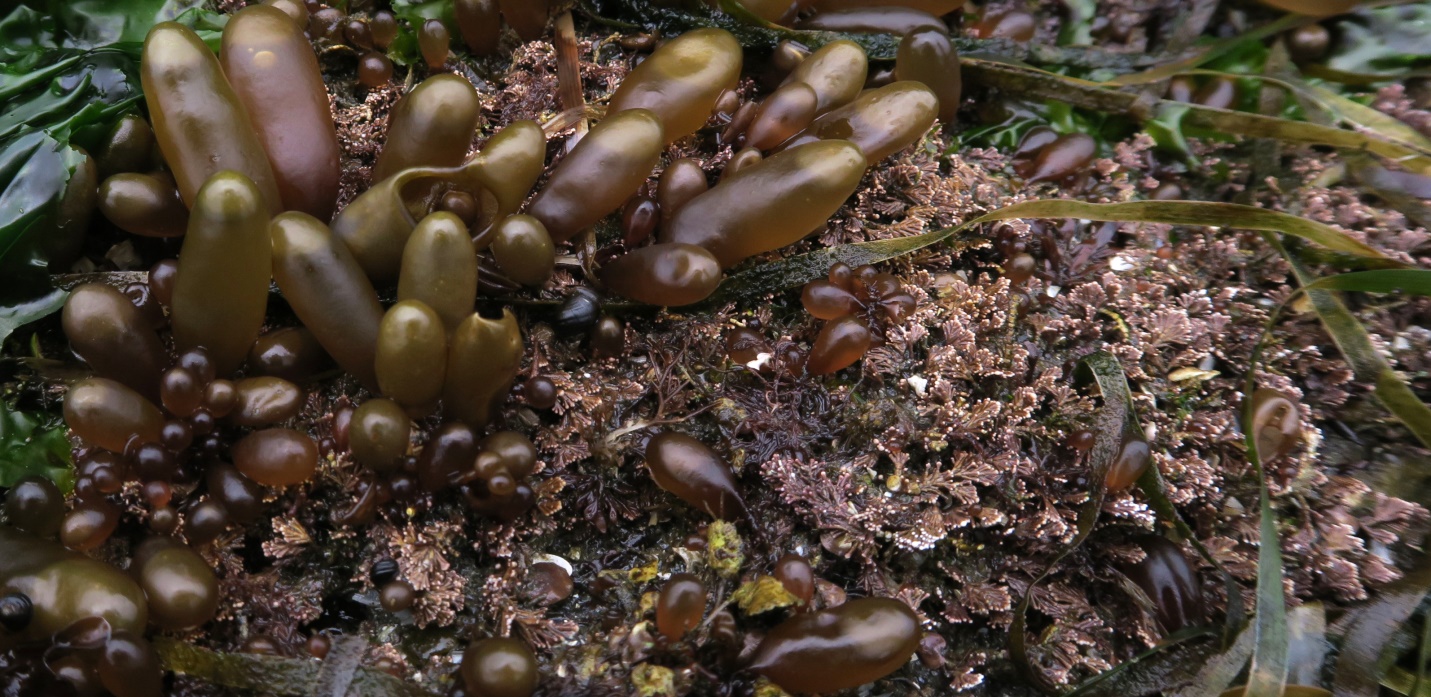
Figure 3: Corallina vancouveriensis serves as the anchoring ‘structure’ for these Sea Sacs, Halosaccion glandiforme, to grow from; Port San Juan, BC, Canada. June 10, 2020. Photo ID 27195 ©Seaweedwhisperings.com
Further Observations & Impressions:
Person 1:
Suddenly felt extreme doubt.
Did I make a mistake? I won’t admit that!
On to the next impulse.
This energy follows its urges.
And isn’t yet ready to really learn; they’re doing, not learning.
Taking things on face value.
Not analyzing information coming in, but making snap judgments.
No second thoughts, questioning or checking validity. This could be a spouse who complies with the strong opinions of their partner or persons swept along by the bold rhetoric of a populist leader.
They can thrive under the guidance of an influential mentor/teacher.
This seaweed is content with its place in life.
Repeating familiar pleasures, over and over, without reflection. Just automatically.
They want to be free to do things, and to do it their way.
Like a child who is enjoying their play, they also don’t want to stop or be interrupted.
Abrupt mood swings. Happiness with simple pleasures can be abruptly upset, but will bounce back quite readily.
Upset and extremely uncomfortable when challenged. There is a naïve feeling of “I’m right”, and a denial that things could be otherwise. “Don’t even suggest that I am wrong; I don’t want to hear it!”
Person 2:
Small is my size, my place.
Small is safe.
No place to get to. No hurry to get there.
But, oh, if I fan out here, I might just take a peek – what’s out there in the world?
I want solid footing – a home on the rocks; not sand or mud or other things (backs of chitons or skin of whales).
Fan out, yes! But “the base” matters.
Rounded and tough – things roll off and around me.
Stuck in place – can’t go/reach far.
Lonely sometimes, but then forget the feeling – doesn’t linger, rolls away.
Other’s use me – as their shelter. Do they bring me anything in exchange?
I do grow – it’s just slow.
Up in the fringes, I’m just fine (high intertidal) where others much bigger and faster can’t thrive.
I look like a fringe (lace).
I can live in the fringes.
I’m not just pretty – I’m tough.
Can’t connect very deeply with this seaweed it seems. Almost do, then concepts/thoughts roll away, out of my grasp.
Does this seaweed not connect well with others/the world? Self-centered? Small focus? Though unaware that it’s small.
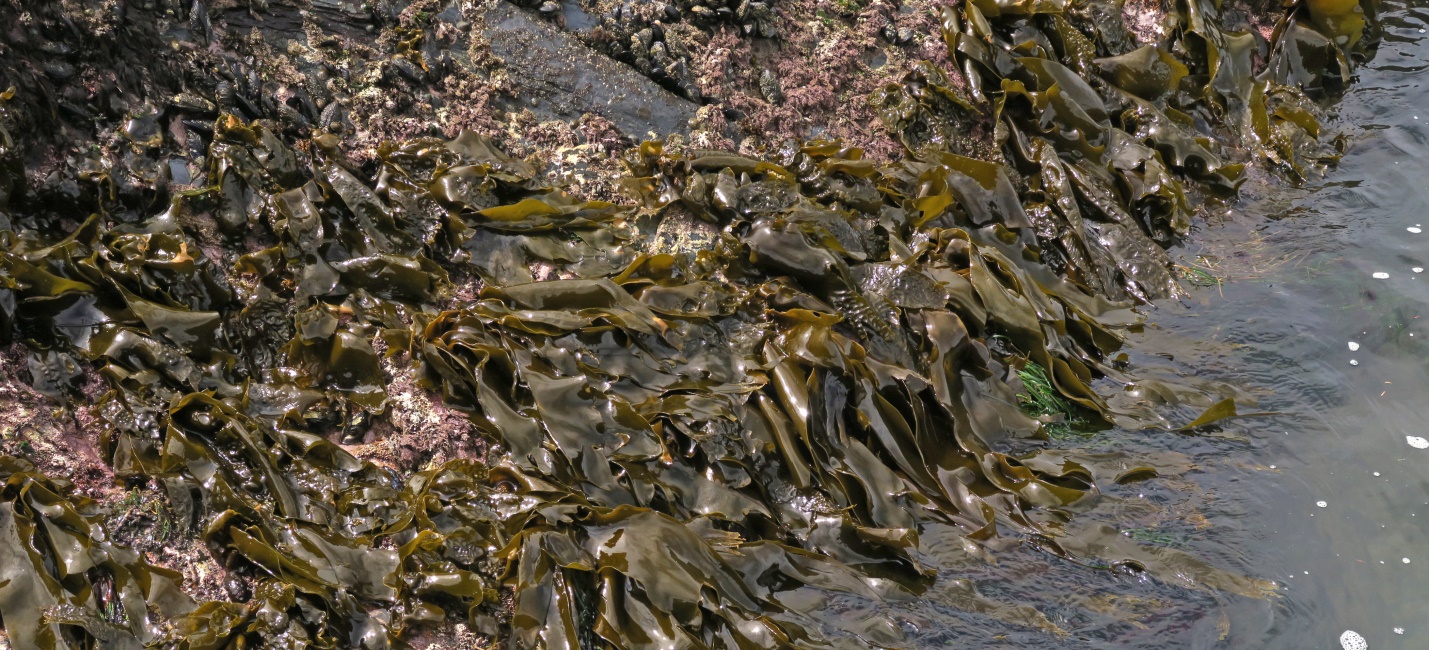
Figure 4: Extensive mats of Corallina vancouveriensis carpet the rocky headlands where Sea Cabbage, Saccharina sessilis, also grows. When immersed the far larger stems of this brown kelp float above the coralline algae allowing better access to sunlight. The large kelp blades also serve to keep the coralline algae beneath them better hydrated when the tide is out. Botany Bay, Juan de Fuca Strait, BC. April 12 2020 Photo ID 27196 ©Seaweedwhisperings.com
Discussion:
No place to get to, no hurry to get there; this energy was clearly experienced during this Whispering. On the one hand this can look like “not looking to evolve”. But, on the other hand (this is a very ‘fitting’ expression for this seaweed in that Corallina vancouveriensis has the bilateral symmetry to its morphology), this seaweed is actually so new in its place that being fully expressed there and ready to move on and to evolve is not really a reality. That would be premature. There is so much to grasp right where they are. This was experienced as “the base matters”, it anchors you so you can explore within your reach, and “wanting a solid footing” describes the type of safety this seaweed energy needs to do its exploring and growing.
So, while there was the feeling of being “stuck in place” and “can’t go/reach far” this was actually a perspective from “outside” of the seaweed energy. To others, this energy can seem slow growing, or barely moving, however Corallina is “reaching up and out” – it’s just doing this on its own scale and at its own pace.
We had the concept of “ignorance is bliss” rolling around in our thoughts for a while with regards to this seaweed. It was a feeling that they do not want to find out they are wrong, they’re not yet ready to reflect on their errors. Feedback, you might say, “rolls off” their rounded tips and pours back into the ocean. It is not that this energy is ignorant…, it is that they are like a “brand new page” that nothing has yet been written upon. They are fresh. They are also unaware.
Concentric circles…, this seaweed is at the ‘center’ – it’s self-centered!
You ARE the center in this type of energy – you are SELF-centered.
There is the concept of ‘the view is complete’. Like being in the middle of a circle – every direction you look is the same, and you are still at the same point – “staying put” in the center. A complete view – almost like there’s no notion of anything beyond that yet. With the geometry of a circle it is a fact that this is only two dimensional (a circle is NOT a sphere), so you’re only seeing things on one plane. You can’t go beyond these dimensions, can’t quite imagine beyond these dimensions, yet. If you could go to three dimensions, there’d be some introspection and ability to look outside one’s own view.
Lives on fringes this seaweed, yes, but likes tide pools. In tide pools, this seaweed stands out, but it’s a small world so we have the quality of “big fish in a small pond”. Being in the tide pool, or in rock crevices, means they are safe from being crushed by larger trespassers, and also gives some hydration when tides are low. However, being in the tide pools and the rock crevices creates a problem, too. These are the “low” areas – so if Corallina wants to “raise its hand” and be noticed, they are doing so from a disadvantageous position, they’re not likely to be seen.
Fossilized, stiff form, slow growing, can be difficult to connect with. This energy is an interesting one, maybe not so fully plant/algal-like in nature, almost like a ‘mineral/algal’ combination. Being new to the algal/plant ‘scene’ maybe there is a need for some protection – a calcified coat of pink “armour”. What is in your insides, under the armour, Corallina? No one can see that, touch that. Do you share it? Not much actually, is what we sensed. Upon reviewing photos made of Corallina vancouveriensis from many different locations, it was notable that they all “looked much the same”. Finding a new ‘perspective’ or a different impression to present from amongst the photos was not really possible. The thought arose – does this become boring and uninteresting to the beholder? Yes, we concluded, it can. The ‘background’ becomes the place this pretty pink alga occupies, as if it does not yet have reliable ways to attract individual attention.
But looking at the photographs did impress the concept of round/sphere/circle. There is the roundness of all the branch tips, and the scalloping round shapes of the basal crust, and the initial round sphere that ‘erupts’ from that crust.
This links with that image of the concentric circles.
Corallina is alone at the center of its own circle, AND your “self” at the center feels just fine, totally “right”.
Corallina’s world view is not complicated. However, there is a need for sustenance and the Corallina individual can be “simply” needy. They like to hear, “I like you”, or “you’re the best”, or “you’re great”. Simple compliments feel very good, indeed. They feed the ego; and, yes, ego-centric fits the concept of concentric circles. Input that validates the ego is not just welcomed, it is needed. Needed to ‘grow’ something for the seaweed. In this seaweed energy the ego is just learning its place in the world, too.
Short-sighted – they can lack the ability to see the ‘big picture’ or to know about other possible perspectives. As the center of their own circle, their range of ‘vision’ is limited to that same circle and possibly a circle whose horizon is very short also due to their low lying (in the rock crevice and tide pool) position. With the short-sightedness they can be stubborn, unyielding, even rather willful in their inflexibility. They don’t seem to budge. They don’t change their opinions or positions. This short-sightedness can even be about themselves; they hold a rather fixed view of themselves and it can be a view that is surprisingly proud or haughty.
Even if their self-opinion is a bit more modest, this budding ego needs food. There is a need for a constant stream of input or entertainment – most importantly acknowledgment and even better, adulation.
Corallina vancouveriensis can be the physical ‘anchor’ for other life forms and other macroalgae including Sea Sacs, Halosaccion glandiforme. As such, it has the rather ignominious position of being largely outshone by the opportunistic and successful newcomers. Growing low to the rocks, it also can be covered over by larger, faster growing seaweeds such as Sea Cabbage, Saccharina sessilis. There is an element of embarrassment here, like cheeks blushing ‘pink’ after a mortifying revelation. Corallina really would like some admiration and respect, instead it’s just landed upon, ‘used’ as needed and obscured and even almost completely out shadowed by others.
When obscured like this, there can be efforts that Corallina puts out that are quite impulsive. Blurting out a comment here, jumping in to participate where they are uninvited there…, with efforts like this problems can arise. The Graceful Coral Seaweed can then seem to be lacking ‘grace’, actually, and seems to appear almost disgraced or mortified for their dismissal – it is best to return to center, Corallina concludes.
“Ignorance is bliss” – this phrase can be considered here once more. The energy is not ignorant, not at all, but being unaware of consequences allows for the bliss, delight and simple pleasure. In their “blurting out” style they can spawn original ideas, initiate new ways to do something, launch new forms of artistic expression – all with a notable quality of spontaneity. Sometimes they ‘hit the bullseye’ the first time they take up a bow and arrow. They have this potential because there is a considerable freedom that comes from not worrying about/giving thought to consequences.
This young/youthful energy is very much at the “taking in” stage. Much is coming in, and it can be interesting and stimulating but not much of it is processed. They don’t or can’t do much with all that is coming in and they also don’t feel a need to process all of it anyway as it’s just continually coming in. It’s the freshness and newness of just starting out.
Impatience can be a factor. With the impulsivity there is often the need for reward – now! Feedback or recognition that isn’t pretty much instantaneous is not gratifying to this seaweed’s energy. Sometimes Corallina can have the kind of inspiration and creativity and ability that truly does result in efforts that are much admired and appreciated. However, this kind of thing can often seem to appear ‘out of nowhere’ and it’s like a first time Olympic competitor winning the gold medal or a previously unknown author winning a top prize for literature, those who have been working in the field a lot longer have some distrust and some resentment for the ‘upstart’ or sudden ‘newcomer’ in their ranks. This kind of Corallina effort that is undisputedly recognized can have a useful ripple effect, though – it can usher out complacency and bring in fresh concepts.
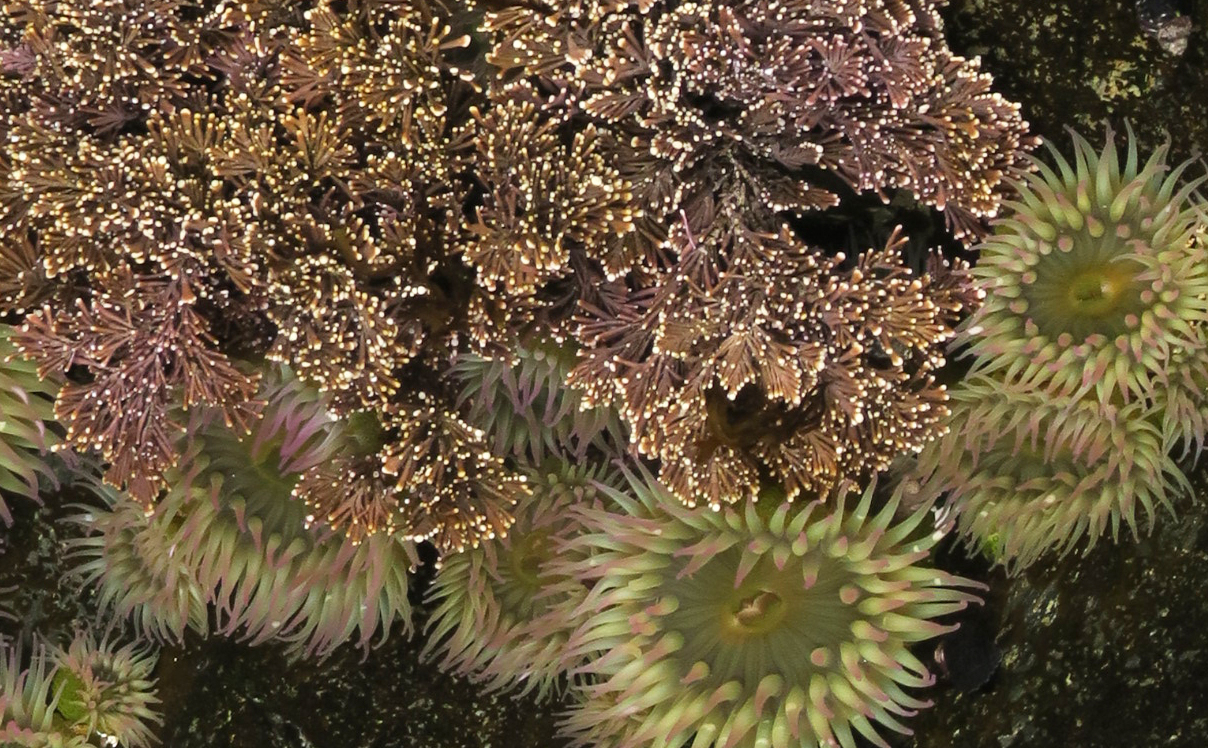
Figure 5: Corallina vancouveriensis growing in association with Anthopleura elegantissima in this tide pool habitat. Harling Point, Juan de Fuca Strait, BC, Canada. May 4, 2020. Photo ID 27197 ©Seaweedwhisperings.com
Biology & Natural History Information:
Habitat: This species forms dense mats on emergent bedrock or in tide pools in the mid to low intertidal and the upper subtidal regions of exposed habitats. Graceful Coral Seaweed grows on exposed outer coasts but mainly in areas protected from the strongest surf. It is an opportunist and can rapidly colonize new spaces on rocks in the low intertidal zone. Erect branches can also arise fairly quickly from previously established crusts.
World Distribution: Bering Sea and Aleutian Is., Alaska, to Baja California, Mexico; Galapagos Islands; Japan.
Description: Thallus is calcareous, articulated, light pink to light purple, forming dense tufts to 6 or more cm tall from a basal crust. Branching is pinnate to verticillate, and dense. Axial segments are 1 mm long and more or less cylindrical. Reproductive conceptacles are located at tips of branches but are rare. Both the base and branches are pink to slightly purple, but can bleach white if exposed to excessive sunshine during low tide, however, this species can usually withstand several hours of exposure.
Like other articulated coralline algae, this vertically oriented species deposits calcium carbonate while retaining chlorophyll and the ability to photosynthesize. The segments are heavily calcified and connected by inconspicuous un-calcified joints.
A key issue in this seaweed is the balance between desiccation and food production (photosynthesis). Aggregation of upright branches of Graceful Coral Seaweed into turfs decreases the productivity of each branch, likely due to self-shading or limited exposure to nutrients. This dense branching however has a positive benefit in that this growth form is more resistant to desiccation and allows Graceful Coral Seaweed to live higher on the shore than many other calcified algae. A study in southern California found an interesting association between this seaweed and the Aggregating Anemone (Anthopleura elegantissima). When growing in a bed of this anemone, the coralline alga grew with more open branches that showed high rates of photosynthesis. Researchers concluded that the anemones held water which helped the alga avoid desiccation.
Reproduction: Species have an alternation of isomorphic (being of identical or similar form, shape, structure) generations, and male and female conceptacles (specialized cavities containing reproductive organs) occur on separate plants. Tetrasporangia (a sporangia having four asexual spores) are zonately divided; sometimes they are replaced by bisporangia (sporangia containing two spores each).
Various epiphytes such as bryozoans and encrusting corallines grow on the Graceful Coral Seaweed.
This seaweed has a very low caloric value (1.03 calories per gram of dry weight).
Classification:
Phylum: Rhodophyta
Class: Florideophyceae
Order: Corallinales
Family: Corallinaceae
Species: Corallina vancouveriensis Yendo 1902
Previous name(s): Corallina aculeatea, Croallina gracilis f. densa, Corallina densa.
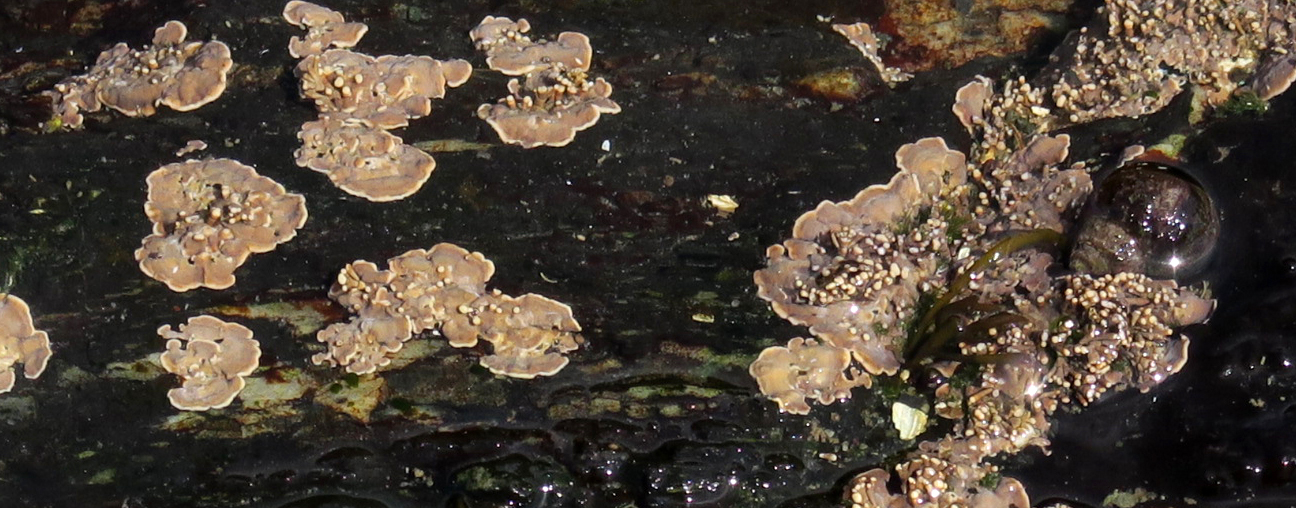
Figure 6: Corallina vancouveriensis pictured here newly budding from basal crusts – Harling Point, Juan de Fuca Strait, BC, Canada. May 9, 2020. Photo ID 27198 ©Seaweedwhisperings.com
![]()